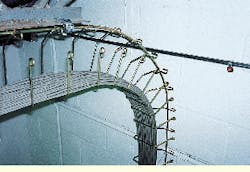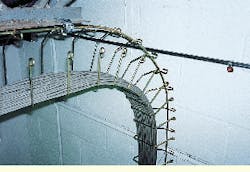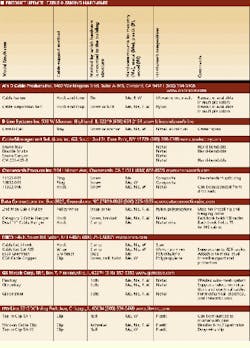Cable-hanging hardware supports horizontal cabling runs
Patrick McLaughlin
Routing cable throughout a telecommunications network is a constant battle against the law of gravity. While nature pulls the cable downward, cable installers and cable-plant managers are tasked with keeping the cable supported so that it does not sag. This requirement is especially critical, although frequently ignored, above suspended ceilings. Good professional practice dictates that cables not be allowed to rest on ceiling tiles because the tiles can be damaged and, more important from a network administrator`s perspective, the cables are prone to damage whenever anyone needs access above the ceiling.
Fortunately for cabling installers and end-users, several types of cable-hanging hardware have been developed for this very purpose. A look at the available products reveals that there are many ways to support horizontal cable runs. Rings, clips, clamps, hooks, as well as hook-and-loop straps are all widely used.
An important consideration when choosing cable-hanging hardware is the sensitivity of the cable being supported, says Louis Chompff, vice president of A`n D Cable Products Inc. "For fiber-optic, Category 5, and enhanced Category 5 cables, handling the cable nicely and gently is important," he says.
Mike Fennell, president of The Rip-Tie Co., agrees. "Fiber-optic cables particularly need to be handled gently," he says. "So do Category 5 cables. Crimping down on them will degrade their performance and their ability to push through 100 megabits per second." He says that the product development undertaken by his company has been in response to changes in the cable materials used today.
Both A`n D and Rip-Tie offer hook-and-loop cable hangers. According to Fennell, this type of material allows for speedy installations. "When an installer uses hook-and-loop products, he puts his clippers in his back pocket," Fennell says, alluding to some cable-hanging equipment that must be cut or clipped during installation. "That`s especially important for installers who work on ladders."
Reusable materials
Fennell says that another benefit of a hook-and-loop product is that it is reusable. "Most of our products are good for heavy, repetitive use," he states. He adds, however, that a recent addition to the product line includes a molded rather than woven hook. "The manufacturing process is less expensive, which results in the product`s being less expensive. The molded hook has become popular for use behind computers, and it is good for approximately 300 release cycles. In reality, 300 release cycles is about 20 years."
Scott English, president of cabling-installation company Data Structures Inc. (Louisville, CO), uses hook-and-loop materials in telecommunications closets. "I find they`re beneficial in managing patch cords," he says.
For longer cable runs, he most often relies on J-hooks for several reasons. "J-hooks go up quickly," he says, "and they`re flexible. A lot of times in the real world, the building structure won`t allow you to put trays in the ceiling. I`ve done installations in buildings that have concrete ceilings without trusses, and in other buildings that wouldn`t accommodate the use of trays."
Flexible pathways
"Separate cable supports, such as J-hooks, lend themselves to providing a customized pathway," English continues. "I have done installations in which the cable path had to go up 2 feet at a 45o angle. Metal trays often can`t do that." He says that even though metal trays typically include corner pieces, often those pieces do not conform to the peculiarities of the cable path in a particular building.
Roger Jette, president of Cable Management Solutions (cms), says the metal trays his company manufactures can do exactly that. "With fixed, rigid trays, the path has to be consistent. But the products we manufacture can bend to any angle without any special tooling." cms produces a line of metal cable-support products that are bendable by hand and can be bent into and out of any position repeatedly. These qualities, he says, eliminate both the need to purchase corner pieces and the possibility that such a corner piece will not accommodate the sometimes unusual turns within a cable path.
Cable-hanging devices made of metal provide other benefits, Jette adds. "Metal trays can accommodate runs of many cables," he says. He also points out that trays provide consistent support throughout the length of the cable, as opposed to products that provide intermittent support every few feet. He maintains that trays are a good method of supporting high-bandwidth cables. "Cables carrying high bit rates don`t tolerate bending or sagging, and using a tray protects against both. If you`re only running a few cables, a ring probably isn`t a bad choice," Jette continues. "But for multiple cables, the tray is a better option."
Cable sensitivity
English agrees that concern over the treatment of high-performance cables is justified. "I think many people are concerned about the unknown," he says. "I don`t use bridle rings because the cables at the bottom of the ring can get kinked. In conversations with my peers in the industry, I have heard some of them say that cable trays are a better choice than J-hooks because cables can be laid loosely into trays. It`s not a major consideration with Category 5 cables, but with higher-performing cables, I think it is."
English would like to see some official tests conducted in which horizontal runs of many cables are placed into trays and tested for performance, then placed into J-hooks and tested for performance. In reality, cabling installers are without the luxury of having enough time to conduct such tests for themselves.
Fennell and Chompff stress that hook-and-loop cable-hanging equipment allows for simple cable identification. "Our products are available in 10 different colors, which helps with identification," Fennell says.
"Because of the number of applications available to users today," Chompff adds, "proper cable identification is important. Hook-and-loop fasteners allow for color coding." He says that identification of individual wires and cables should also be addressed.
English personally does not use cable-support systems to help identify cables. "I label every cable on each end," he says. This practice is in compliance with tia/eia-606, the standard that specifies cable-plant administration. "The cable-support system really does not have a bearing on the actual marking of the cables."
The metal cable-hanging equipment available from Cable Management Solutions can bend to route cable around corners.
Hook-and-loop products, such as these from The Rip-Tie Co., are reusable.



